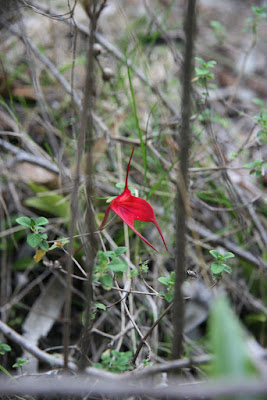Masdevallia barlaeana is native to Peru. These orchids grow on rocky habitats near Cuzco, at an altitude of 2800-2900 m.
Masdevallia barlaeana also called as Barla's Masdevallia (named to honor the Brazilian Orchid Enthusiast), is a species of the genus Masdevallia. This species was described by Heinrich Gustav Reichenbach in 1876. This species is named in honor of J. E. Barla, botanist and orchidologist, Consul of Brazil, and director of the Museum of Natural History in Nice, France. It was originally discovered by Walter Davis in 1865 (who was searching for Masdevallia veitchiana to collect for Messrs. Veitch).
IDENTIFY MASDEVALLIA BARLAEANA
Masdevallia barlaeana is native to Peru. These orchids grow on rocky habitats near Cuzco, at an altitude of 2800-2900 m. They are also found in humus and mosses growing on rocks near Urubamba, at an altitude of 2400 m.
It is a miniature sized, caespitose, lithophytic, cold growing species, which reaching 7-18 cm in height, with grass and small shrubs with a ramicaul that is enveloped basally by several, short, tubular sheaths with a single, apical, oblanceolate, petiolate, long attenuate, 5-13 cm long and 1.5-2.2 cm wide leaf that is minutely tridentate at the apex.
Barla's Masdevallia blooms in the summer and fall with a slender, erect, 10" (25 cm) long, single flowered inflorescence with lanceolate, acuminate floral bracts that are half the length of the ovary holding the campanulate flower above the leaves. The size of the flower is about 3 cm. The outer whorls are bright reddish purple and have darker red or purple discolorations or veins. On the inside, they are covered with very short hairs and spread out beyond the tube formed by these petals. The dorsal petal is connected at the base to the side external flakes to form a cylindrical tube. The rounded free parts of the tips are narrowing rapidly to form a slender tail. The side outer petals are connected to each other. The inner whorls, the lip and the prick are white, but the lip has pink streaks at the top.
MASDEVALLIA BARLAEANA CARE AND CULTURE
A creeping rhizome often causes Masdevallia barlaeana to grow out of the pot. These plants usually bloom with small breaks from mid-summer to winter. They are easy to grow and quickly reach significant sizes. Sometimes there are problems with flowering, especially when they are grown in too warm conditions.
Light:
Masdevallia barlaeana needs a light level of 10000-18000 lux. The light should be filtered or dispersed, and the plants should never be exposed to direct sunlight. You need to ensure continuous, strong air movement. These plants will grow well close to the outlet of a strong, cool, moist stream of air from a cool humidifier.
Temperature:
The average temperature of the summer day is 23-25 ° C, the night 9-10 ° C, and the daily difference is 13-15 ° C. The average temperature of the winter day is 23-24 ° C, the night 2-4 ° C, and the daily difference is 20-22 ° C.
Humidity:
For most of the year, Barla's Masdevallia need the humidity of 70-80%, and in the period of 2-3 months dry season in winter it drops to 55-60%.
Substrate, growing media and repotting:
Masdevallia barlaeana are usually grown in pots filled with loose, quickly drying media. It is usually a small bark, often mixed with various amounts of ingredients such as chopped sphagnum, perlite and charcoal.
It is recommend to repotting each year. They are usually carried out in late winter or early spring, but this can be done in any period from autumn to spring unless it interferes with flowering.
Watering:
This species should be evenly moist during active growth from late spring to autumn, but at the end of autumn the amount of water should be reduced.
Fertilizer:
It is recommended to use 1/4-1/2 of a balanced fertilizer for orchids every 3-4 weeks if the plants are grown in sphagnum, tree fern fibers or osmunda ferns. When growing in bark, fertilization should be applied every 1-2 weeks.
Rest period:
In winter, the amount of water for Masdevallia barlaeana should be slightly reduced, but they should not be allowed to dry completely. Fertilization should be reduced until spring, when the amount of water increases.















COMMENTS